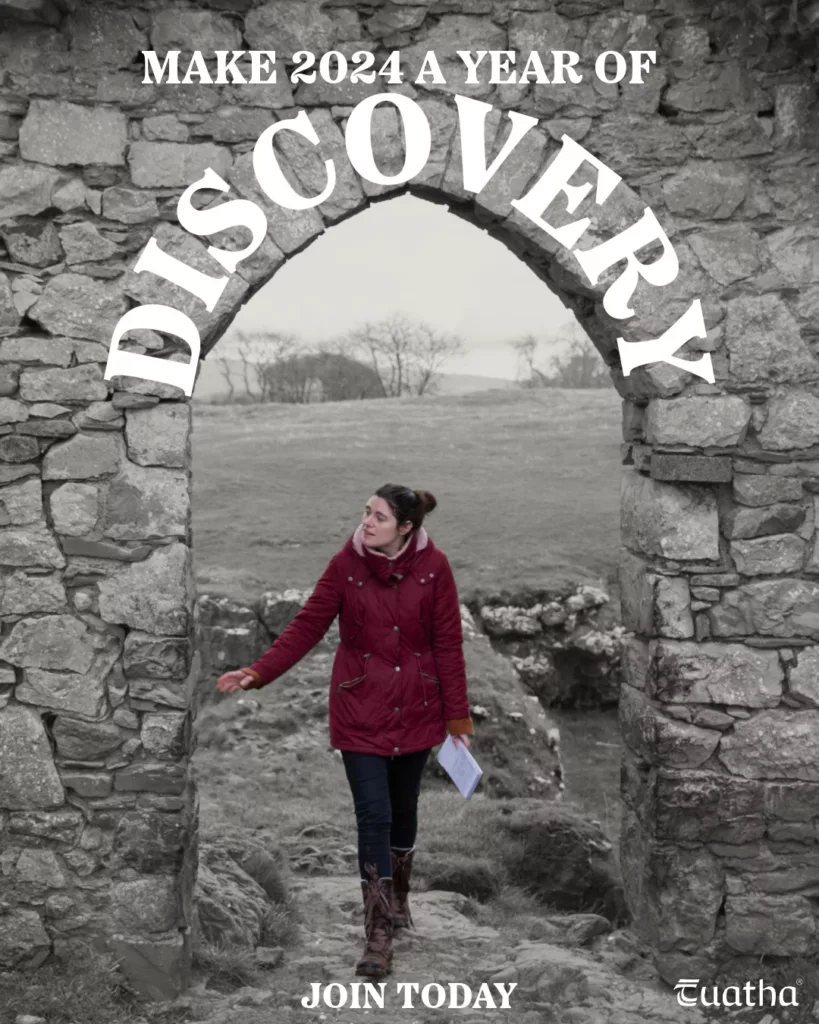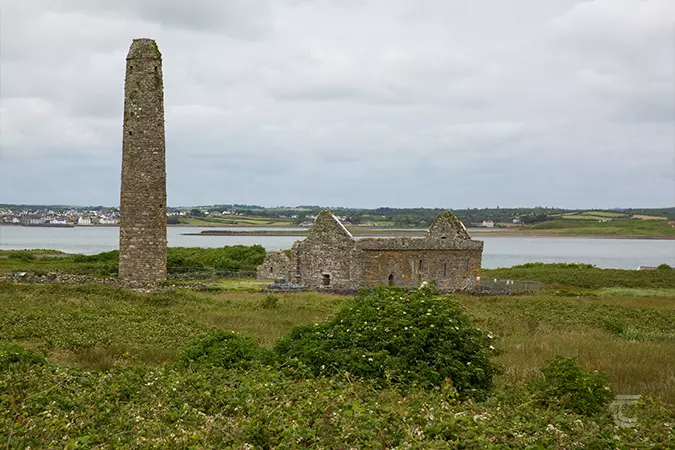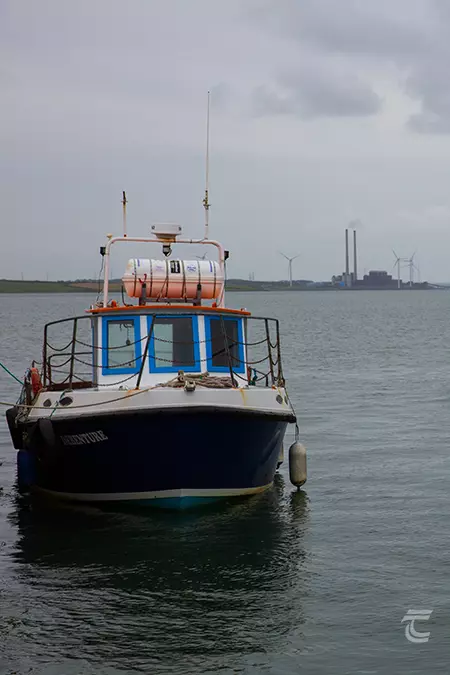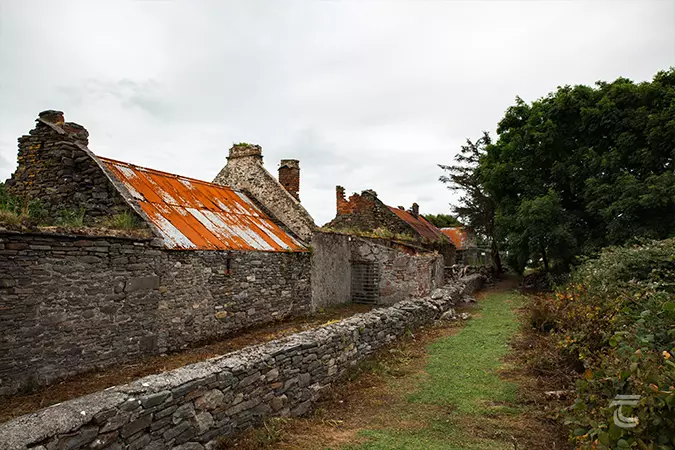Scattery Island
Scattery Island lies in the Shannon Estuary, in County Clare. The island was inhabited until the late 1970s, and you can still see the fields, boreens and deserted buildings left by the islanders. Today it is quite overgrown, though fortunate visitors might catch a glimpse of the resident hen harriers of the island that prey upon the multitude of rabbits that have made the island their home.
As well as abundant wildlife, the island is rich in historical sites, with an important collection of monastic and church remains associated with St Senán. He was an influential figure in the early Irish church, and is credited with being the tutor of Ciarán of Clonmacnoise. When he was a very young child, he showed wisdom and erudition far beyond his years and so his mother named him Senán, meaning ‘The Old’. He is credited with many miraculous feats, and perhaps the most famous of his stories is the battle with the monster of Scattery Island. In Irish, Scattery Island is called Inis Cathaigh (meaning the Cathach’s Island). This refers to the legend of the Cathach, a large serpent-like monster who made the island its lair. The Cathach was a menace to all that approached the island, and regularly attacked boats to devour the sailors, who were helpless in the face of the monster’s ferocity. Saint Senán was said to have faced the Cathach with his arms spread wide in prayer. He banished the monster to a lake called Dubhloch, near Mount Callan, some believe that it still lurks in the dark depths of the lake to this day.
Scattery was raided and eventually settled by the Vikings, until it was recaptured by Brian Boru in AD 977, when Brian’s forces stormed the island and slew Ímar of Limerick and his sons as part of a campaign to drive the Norse from Limerick. However the island was raided again in 1101 by the famous Magnus ‘Barelegs’, King of Norway. Despite this turmoil, the monastery on Scattery Island continued to develop and grow in importance, through the continued patronage of the Dál Cais Kings.
For practical information about visiting this site Click Here
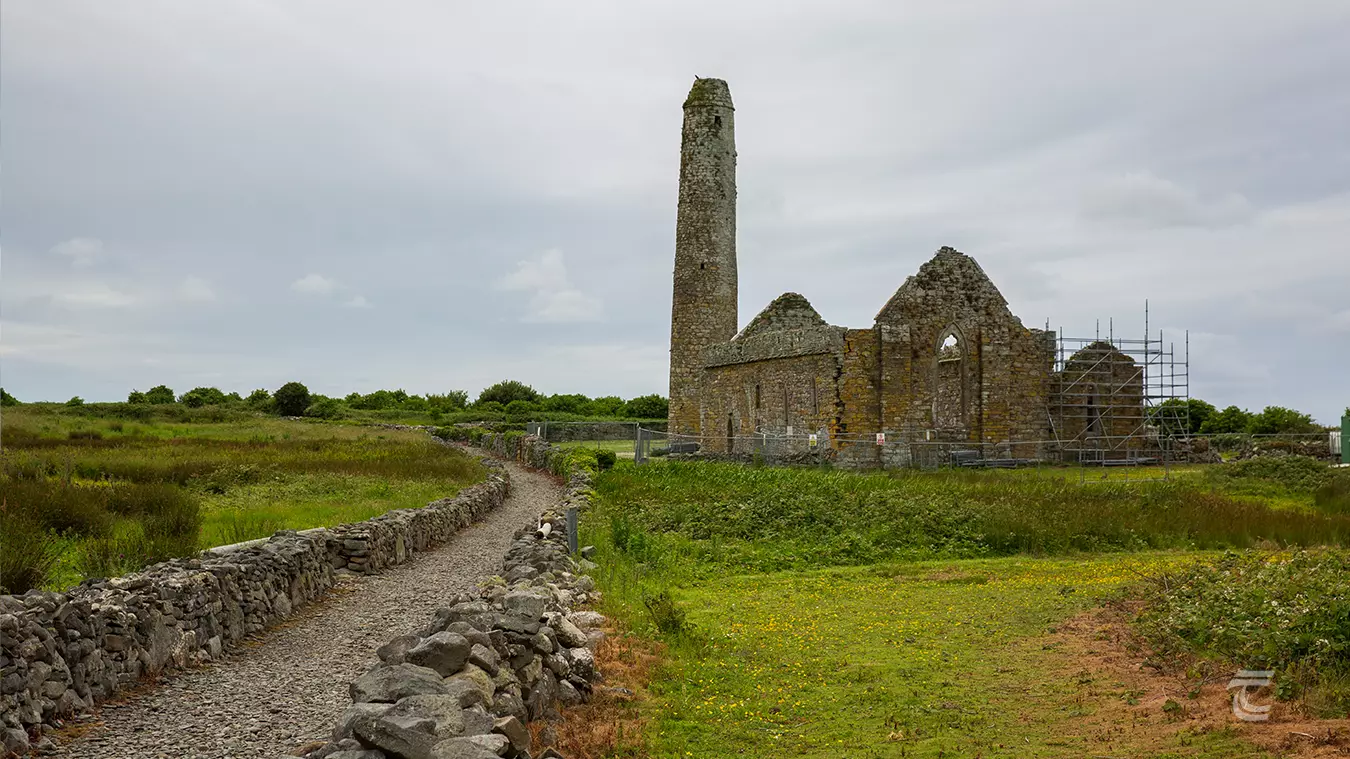
St Mary’s Cathedral, Scattery Island • Clare
Scattery Island Visitor Centre
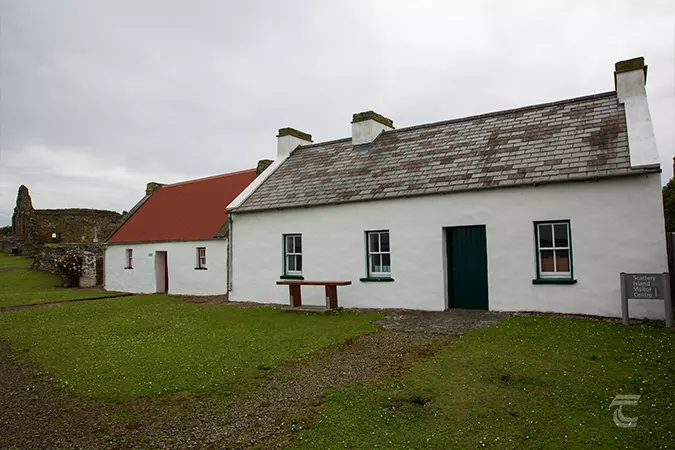
Scattery Island Visitor Centre • Clare
The Visitor Centre is located in a small renovated cottage close to the pier when you land on the island. The centre has a series of panels that relate the history of the island, from its monastic origins and Viking raids, to life in the 19th century, traditions and cultural history of the islanders before they left the island in the 1970s. It also contains an ogham stone that was originally located at St Senan’s Church. Excavations near the visitor centre by archaeologist Dave Pollock to assess the impact of providing visitor facilities on Scattery Island revealed widespread remains of clay floors, metalled surfaces and scorching suggesting a large settlement close to the shore in the medieval period. Material seen under the cottages suggests buildings may have strung themselves out along a shingle spit above the shore, that were replaced in turn by the 19th-century cottages of the small village. Just near to the centre you can also see the base of a medieval towerhouse called Keane’s Castle. There are toilets and picnic benches located at the Visitor Centre.
Teampall na Marbh
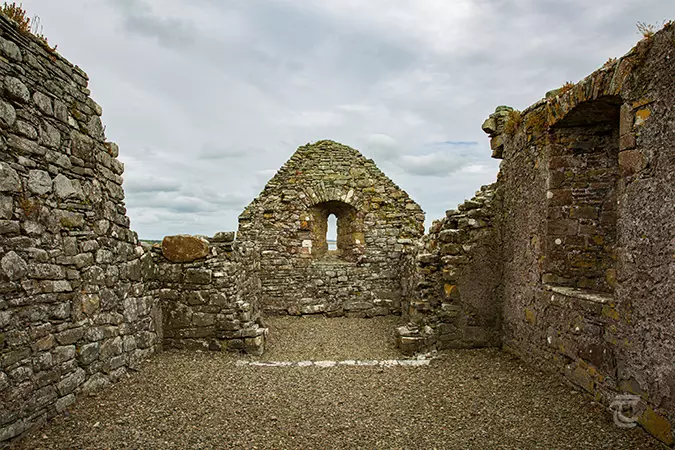
The interior of Teampall na Marbh • Scattery Island
A late medieval church known as Teampall na Marbh, ‘The Church of the Dead’, is one of the first sites you find along the path from the Visitor Centre. This is a rather plain, rectangular church that may have been constructed around the same time as the castle as part of 15th / 16th century development on the island. It consists of a single cell nave and chancel but there was a northern aisle and a sacristy on the north side of the chancel which haven’t survived.Though the church itself is quite plain, it does incorporate some decorative flourishes with the use of dundry and red sandstone in the western door. The graveyard that surrounds it has a number of interesting headstones, and it is still in use even to this day as it is the traditional place of burial for the inhabitants of the island.

The interior of Teampall na Marbh • Scattery Island
The Cathedral of Saints Mary and Senan
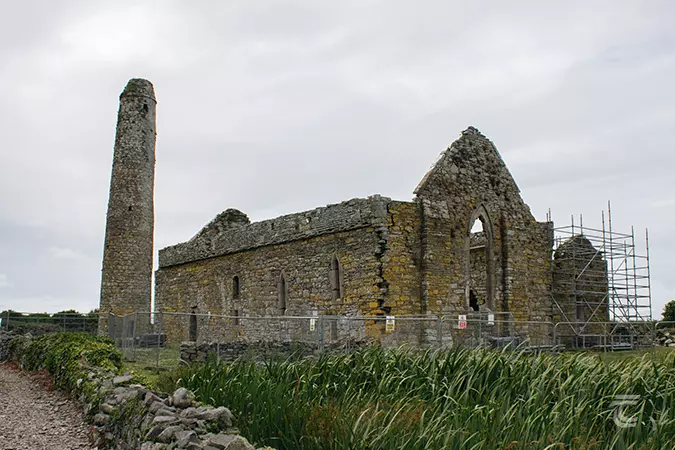
The Cathedral under conservation works • Scattery Island
The main monastic remains can be seen further along the path towards the interior of the island. The Cathedral of Saints Mary and Senan is the largest church on the island. It has distinctive antae, small projections of the side walls beyond the gable walls. The building had been extensively modified throughout the centuries, and it was extended and embellished by Brian Boru and his descendants. The relative grandeur of the building reflects the importance of the Bishop of Inis Cathaigh, who once held sway over a large diocese that incorporated parts of Clare, Limerick and Kerry. A representation of a bishop’s head wearing a mitre can be seen on the outer wall at the apex of the eastern window. It is positioned above two snarling animals whcih may be a fantastical reimagining of the beast that St Senan defeated. The last Bishop of Inis Cathaigh died in 1188, and following the Norman conquest of the region, the once famed monastery began to fall into decline. The diocese of Inis Cathaigh was broken up with its territories absorbed into the dioceses of Killaloe, Limerick and Ardfert. A small nave-and-chancel church stands immediately north of the cathedral, with the Romanesque-style features of this church suggesting a 12th century date.
Scattery Island Round Tower
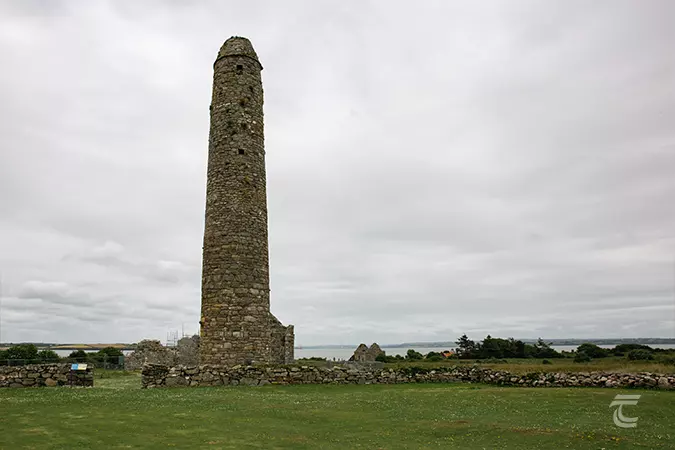
Round Tower • Scattery Island
The round tower is one of the best examples in Ireland. It stands some 26m (85 feet) tall. Unusually, it has its doorway at ground level, making it one of only two, along with Castledermot in Kildare, to have a ground floor entrance. The tower is likely to have been constructed some time between the 10th and 11th centuries. Its conical cap appears stunted, suggesting it may have been damaged in the past, possibly by lightning or strong winds. With the doorway at ground level, it affords a rare opportunity for a visitor to look up all the way to the top, allowing a view of where the floors would once have been secured as well as the light bleeding in from the small windows.

Round Tower • Scattery Island
St Senan’s Well
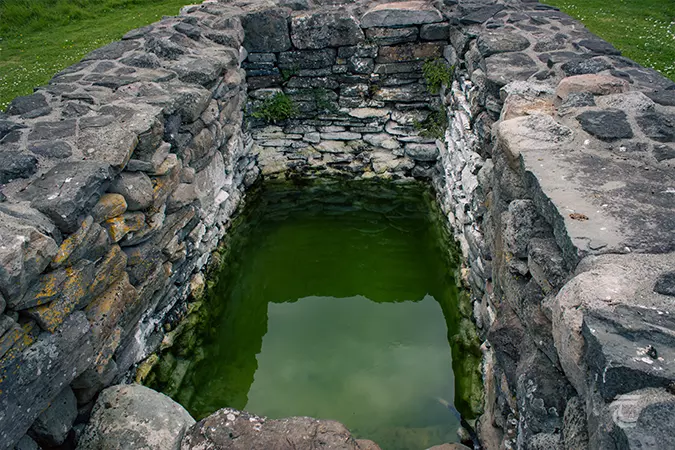
St Senan’s Well • Scattery Island
Not far to the west of the round tower you can see St Senan’s Well. Legend says it appeared when the saint plunged his staff into the ground while praying for water during a drought. The well still features in pilgrimage today, and it is visited during the pattern on March 8th, Senán’s feast day.
Fragmentary traces of the drystone cashel wall that once enclosed the monastery can be seen to the north. By following along the path to the north you will next encounter St Senan’s Church.
St Senan’s Church & St Senan’s Bed
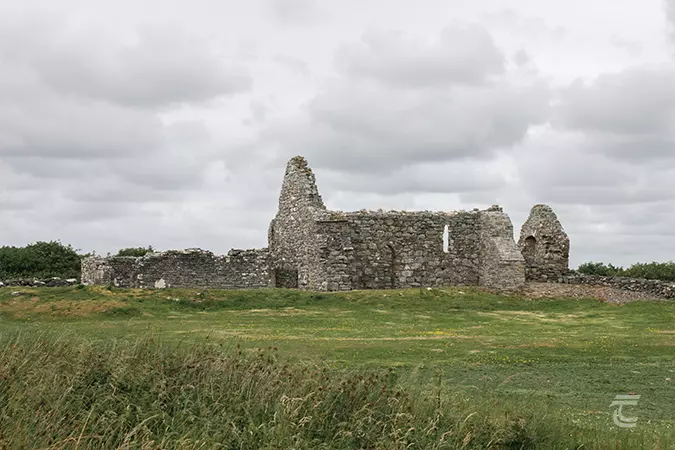
St Senan’s Church & Senan’s Bed • Scattery Island
By following along the path to the north, visitors can see St. Senan’s Church, a small 12th / 13th century church. A smaller church, known as St Senan’s Bed, adjoins the larger church, and is believed to have been constructed over the grave of the saint. St Senan’s Bed has a local tradition that forbids women from entering. Apparently it holds a curse that any woman who goes inside will never have a happy marriage or bear children, which seems more than a little harsh. Behind the church you can see an interesting 9th or 10th century cross-slab, that bears an interlaced Latin cross and an inscription that seeks a prayer for ‘Móenach teacher (aite) of Mugrón’. The ogham stone that is now in the Visitor Centre was moved from this site.

St Senan’s Church & Senan’s Bed • Scattery Island
Knocknanangel
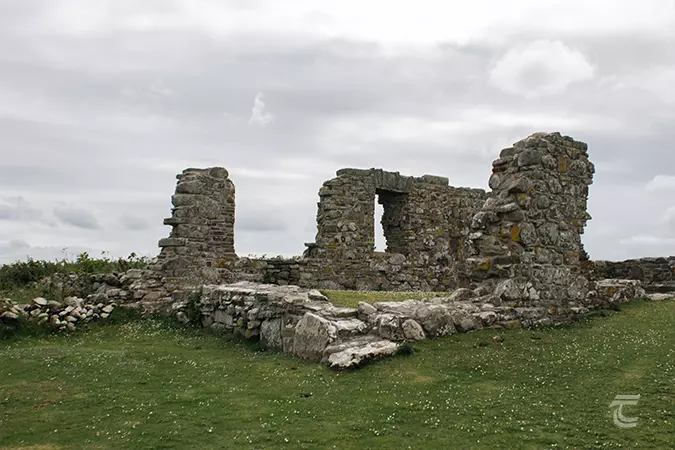
The fragmentary ruin of Knocknanangel • Scattery Island
The highest point of the island is known as Knocknanangel from the Irish Cnoc an Aingeal (‘The Hill of the Angel’) and it is marked by a small church. According to legend, this was the spot where an angel carried St Senán to do battle with the Cathach. The church is in a ruinous and fragmentary condition so it is difficult to establish an accurate date for the building, though it is likely to be around the 12th – 14th centuries given the similarity with the other buildings of that era on the island. It appears to consist of a single-cell structure constructed of unusually large stones and lime mortar.
The Artillery Battery & Scattery Island Lighthouse
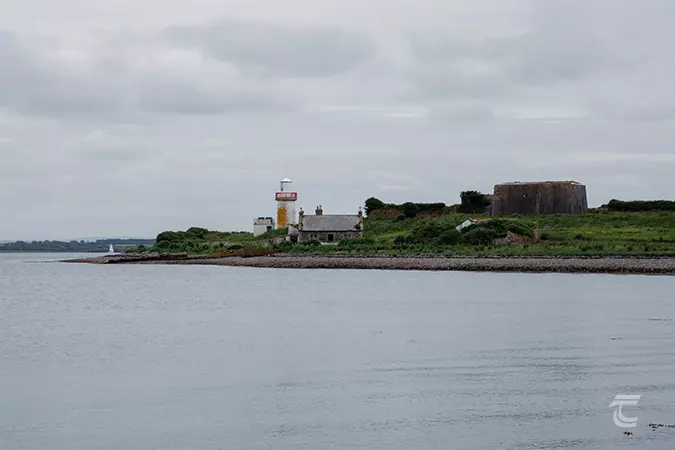
The Artillery Battery & Lighthouse • Scattery Island
A large artillery battery that once protected the mouth of the Shannon was established on the southern tip of the island. It was built by the British Army in 1814, as part of a fortification of Ireland’s coastline during the Napoleonic Wars. It once would have housed up to eight heavy cannon, and along with the battery at Kilcredaun on Loop Head it would have been a formidable obstacle to any hostile ships. A lighthouse stands nearby. As Scattery is in such an important position at the mouth of the Shannon Estuary, there have been a series of lighthouses on the island dating back as far as the 1680s to help to protect shipping. The current lighthouse was built in 1872. Today the lighthouse is fully automated and solar powered.

The Artillery Battery & Lighthouse • Scattery Island
Upper left: a view of the main monastic area • Lower left: the 19th century village • Right: the Scattery Island Ferry
Top: a view of the main monastic area • Middle: the Scattery Island Ferry • Bottom: the 19th century village
Scattery Island Visitor Information
Scattery Island is a wonderfully atmospheric place to visit. Here you’ll find tales of saints battling monsters while exploring a great monastic complex.
Explore more sites on the Wild Atlantic Way
